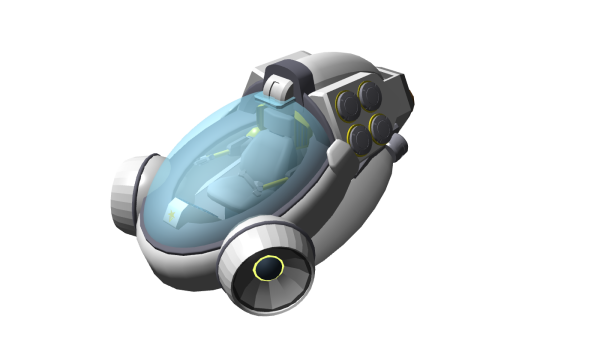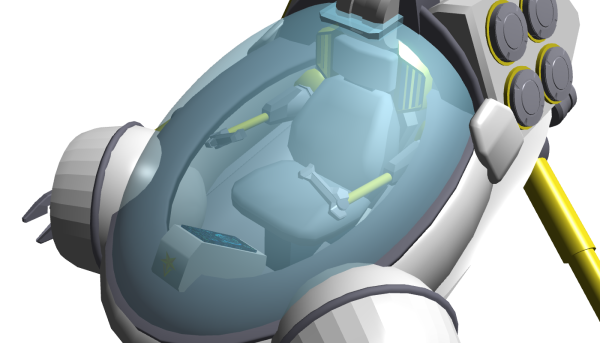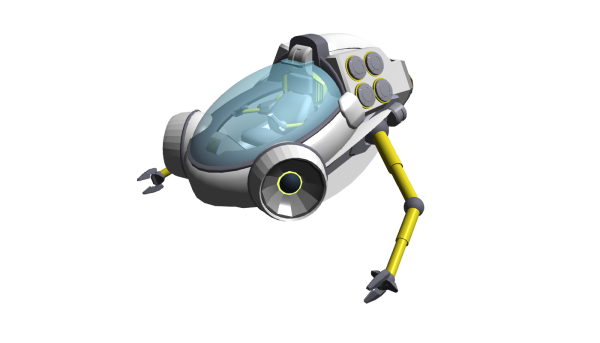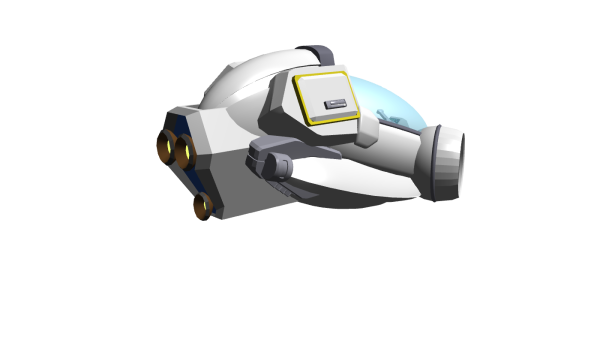Sidebar
Table of Contents
NH-Y3 Guppy-class Exploration and Utility Craft
The Guppy-class is a small craft made to give an operator access to places that a larger ship cannot reach. It is excellently equipped for exploring caves, derelict vessels, planetoids, and other large structures. It is also well-suited to mining, construction, and repair activities thanks to its set of manipulator arms and resourcing/repair equipment.
About the Ship
A multipurpose small craft, the Guppy is equipped for extended usage across a variety of roles.
Key Features
The Carautus, like the Mola that it was designed alongside, has a prominent, transparent dome. A forward pair of over-sized sensors sits on either side of this dome. Normally concealed within two side bays, two manipulator arms can be deployed for a variety of purposes.
Mission Specialization
The Guppy-class is made to facilitate the activities of a parent ship. It can operate as a standalone craft for short periods of time given appropriate support.
Its small profile allows it to access areas that would be challenging for a larger vessel.
The basic Guppy-class is well suited for:
- Exploration
- Search & Rescue
- Mining
- Emergency survival
Appearance
A small vessel with an egg-shaped cockpit area and a number of bulbous protrusions. Two large, pivoting sensor arrays sit to the fore of the 'egg' on either side. The protrusions on either side of the craft's middle area can open to deploy a set of manipulator arms.
The rear of the craft is more angular. One side of the ship has storage for four large resource canisters. The other has a large compartment door. A set of thrusters extends from the rear of the craft's body.
History and Background
As a multi-role ship, the Mola's activities are greatly enhanced by its support vessels. The first vessel, the NH-Y2 Remora-class Utility Craft was focused on mining and Cargo hauling. That left an opening for the Mola's other primary roles of Exploration and Search and Rescue.
Both roles were well served by the Mola's large Multistructs, but finer work could be challenging. Especially when that work needed to be performed in areas that the Mola could not reach. Thus, the engineers at Noval decided on a small form craft with an emphasis on precision maneuverability. It needed to be able to support at least one small Multistruct, in order to carry out its repair duties.
As development continued, the engineers realized that they could scale up the Guppy' resource capacity. Some degree of resource storage was required for the craft's repair capabilities. Expanding on this allowed the craft to act in a mining support role, as well as to have a degree of independent function.
Much like the Mola, the craft is designed primarily for function and forgoes some of Noval's more advanced technology. It does not, however, forgo their attention to detail and adaptive design.
During early development, the Guppy-class followed Noval's traditional naming schema and was known as the 'Cauratus-class'. Both names originate from the craft's bulbous shape and prominent forward 'eyes'. After a number of mishaps due to spelling mistakes and mispronunciations among the design crew, it was changed to the simpler 'Guppy-class' instead.
Statistics and Performance
The Guppy' is focused around maneuverability and the use of its manipulator arms. It is intended for short-range operations, though it can operate in a wide range of environments.
General
- Class: NH-Y3 Guppy-class
- Type: Exploration/Rescue Support Vessel
- Designers: Noval Sourcing, Services, and Logistics, in partnership with Noval Defense, Space, and Security
- Manufacturer: Noval Heavy Industries
- Fielded by: New Dusk Conclave, Independent
- Price: 28,000 DS(5200 KS)
Passengers
- Crew: 1 operator
Dimensions
- Length: 6.1 meters
- Width: 4.5 meters
- Height: 3.16 meters
Due to the Guppy' small size, up to two of the craft can fit within the same amount of space as a standard fighter or shuttle. Noval sells a harness kit for the Mola and other ships with non-standard docking setups to facilitate the extra craft.
Propulsion and Range
- Sublight Engines: .2c
- Air speed: 150 km/h
- Submerged speed: 20 km/h
- Range: 2 months operational window, 5 days supplies and atmosphere
- Lifespan: 5+ years with normal maintenance
- Refit Cycle: 1 year
Damage Capacity
- Tier: 4 (Light Anti-Armor) [Tier 5 Size, Unarmored]
Inside the Ship
Cockpit
The cockpit of the craft is spacious and intuitive in operation. A large dome covers the majority of the cockpit to improve the operator's field of view. To enter the Guppy, the cockpit dome must be raised. Any atmosphere within the craft is stored and released as appropriate.
Piloting the craft is performed by a combination of hand controls and foot pedals. The left foot pedal switches the craft between flight mode and manipulator mode. A HUD is displayed on the cockpit dome, updating with crucial information and updates that the operator might require.
In flight mode, acceleration is handled by the right foot pedal. Steering is performed by working the two hand controls. Lifting the hand controls simultaneously causes the craft to pitch its nose up, causing it to rise (compared to its current orientation). Lifting one control and lowering the other causes the craft to roll. Pushing one control forward and pulling the other back causes the craft to yaw in one rotation or the other. Pulling both back simultaneously while the operator's foot is off of the acceleration pedal will cause the craft to move in reverse.
In manipulator mode, the hand controls become associated with the manipulator arms and rotation of the hand controls becomes unlocked. The acceleration pedal still behaves as usual, but the hand controls now each control one arm. Rather than attempt to replicate an entire arm's worth of movement, the controls are simplified to show where each arm is currently aligned. Movement up, down, and side-to-side adjust where the arm is 'targeting'. Forward and backward movement of the control extends or retracts the associated arm. Lastly, rotation of the hand control causes the manipulator arm's current 'hand' to rotate clockwise or counter-clockwise.
In both modes, the information displayed by the HUD gives the current mode preference. The alternate mode's data is still presented in the operator's periphery.
In the cockpit's forward area, between the operator's legs, is a traditional touch screen interface. It displays the Carautus' operation time, distance and time to the nearest friendly vessel that it could dock with, environmental details, and so forth.
As is standard in all Noval products, the craft's interior is comfortable and well-designed for long periods of use.
Ship Systems
Armored Hull and Hull Integrated Systems
The majority of the Carautus's structure and exterior armor is made of Madite-S, a highly-resilient, self-healing plastic.
Computers and Electronics
The Guppy features two prominent, oversized sensors on either side of its prow. These sensors are capable of determining material composition of large objects, searching for traces of a given signal or material, and operate with a high degree of precision across all available detection bands for a craft of its size. When used together, their precision and range further increase.
To assist its pilot in using a variety of tools and in keeping track of the craft's storage, an easy to use Inventory Management System, or IMS, has been fully integrated into the Guppy' HUD and OS. It displays the craft's current storage capacity, what is currently in storage, and estimated time until a given storage container is full.
The IMS also manages the Guppy' manipulator arm tools and accessories. The ends of each manipulator arm can be easily exchanged between Multistruct, manipulator claw, and any other tool that is located in the default tool storage or in the craft's external storage compartment.
To switch tools, the pilot merely has to select the tool and confirm it on their UI and the Guppy' IMS handles the rest.
Other than the Guppy' more unique features, it also comes standard with an impressive HUD and all other modern electronics that a pilot might expect.
Emergency Systems
The Carautus comes with a number of systems to protect the life of its pilot, including fire suppression and anti-depressurization measures. In the event of a critical failure of the craft itself, the cockpit area can be ejected entirely.
An ARCO-I system is included as an additional safety measure should the cockpit itself fail.
While not an emergency system, per se, the Carautus itself can be an excellent boon to an individual's survival chances. With a diverse set of operational environs ranging from space to sea and the ability to build/repair structures, the Carautus can greatly extend an operator's chances of being rescued. In the event of a stranding, operators are recommended to secure reliable sources of oxygen and water while they wait.
Propulsion
STL Propulsion is provided by an gravitic drive and a set of rear thrusters. The Guppy is a very nimble craft and can easily move in any direction.
In the event of submersion, the Guppy' rear thrusters have been specially designed to use water as a propellant by moving it through a shaped magnetic bottle. While much slower than in space, the Guppy is a perfectly capable underwater exploration vessel.
Manipulator Arms
A pair of manipulator arms can be deployed from within a protective bay on either side of the Guppy. The arms are telescoping and able to extend to nearly three times their stored length.
Each arm can support up to one tool where its hands would be. By default, a set of simple but powerful manipulator claws are equipped.
Within each arm is a set of transport pipes that works in conjunction with the Multistruct tool to collect and transport resources to/from the craft's collection system.
Storage
While small, the Guppy still has a decent amount of space dedicated to the collection of samples and resources. Four large canisters are easily accessible from outside the craft. These are automatically filled by the Guppy' Multistruct tool assembly or can be manually filled from the exterior. Mixing the two “fill modes” is not recommended. When used for construction/repair purposes, the storage containers are drawn from, instead.
The belly of the craft contains an additional storage area that captures the 'overflow' from the Multistruct. In the event that the four main canisters are full or otherwise used, this interior storage begins to fill. It has the same capacity as two canisters and, when provided with empty canisters, will attempt to fill them automatically.
Opposite the resource canisters is an externally accessible storage compartment. Airtight and watertight, it is an excellent place to stow equipment, travel supplies, and other necessary implements that its passenger might require.
This compartment can also be used in conjunction with the Guppy' manipulator arms. In this case, the compartment door is remotely opened. Removing items from the compartment is handled automatically by selecting a given item from the craft's inventory. Items can be deposited in a similar fashion. Images for the Guppy' inventory management system are taken by the manipulator claw's onboard camera.
Shield Systems
The Guppy is protected by a combination of electromagnetic and gravitic shields. These shields are primarily designed for environmental hazards, but offer a reasonable degree of protection in the event of an attack.
An escort in hostile territory is recommended.
Tools
- 2x MultiStruct Multitool (Small)
- 2x Manipulator Claw
- 1x Industrial Cutting Tool
- 1x Industrial Drilling Tool
All tools are interchangeable per arm. Each tool has an additional set of protected sensors and cameras attached to it to facilitate easier use. Other tools can be loaded as needed. While not standard, a “mecha hand” can also be configured as a tool attachment, allowing any tool wield-able by a mecha to also be used by the Guppy.
Tools are stored within the manipulator arm bays to the fore of the compartment. Each tool has a designated storage location that remains closed when the tool is not being swapped out. While stored, tools remain locked in place so that they are safe and secure for its next use.
Availability
The Guppy-class Exploration Craft is available for purchase for 28,000 DS (5200 KS).
OOC Notes
Whisper created this article on 2020/03/16 12:35.
| Products & Items Database | |
|---|---|
| Product Categories | small craft |
| Product Name | Guppy-Class Exploration and Utility Craft |
| Nomenclature | NH-Y3 |
| Manufacturer | Noval Heavy Industries |
| Year Released | YE 42 |
| Price (KS) | 5 ,200.00 KS |
| DR v3 max | Tier 4 |
Page Tools
Terms of Service - Privacy Policy





